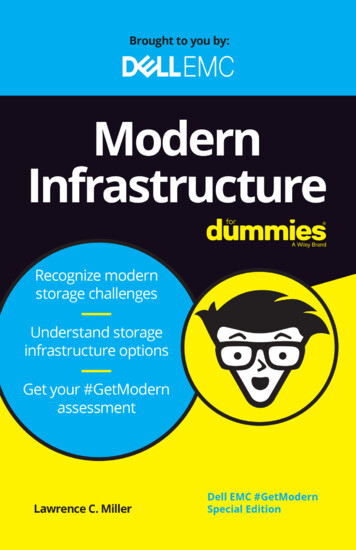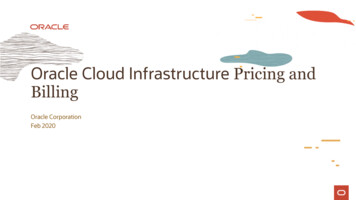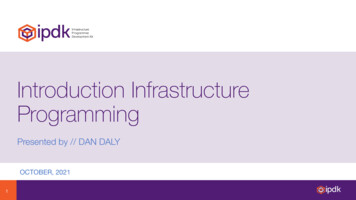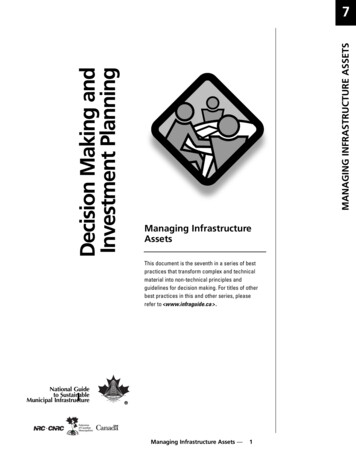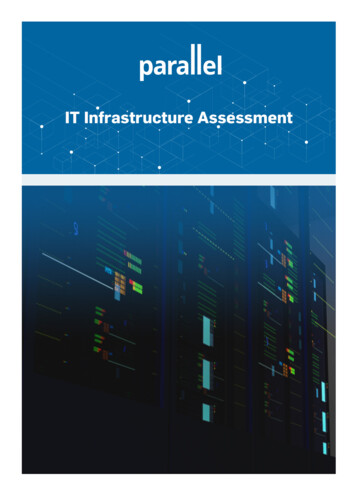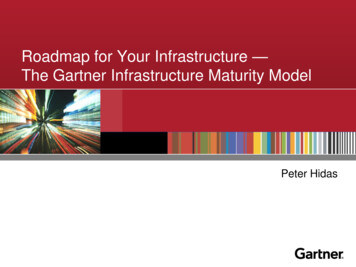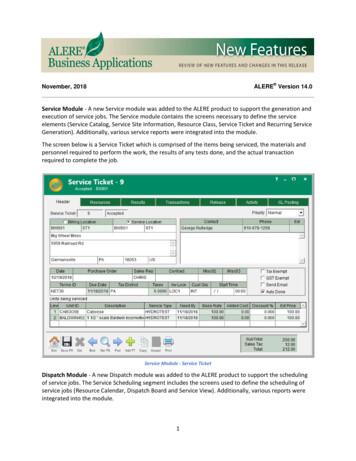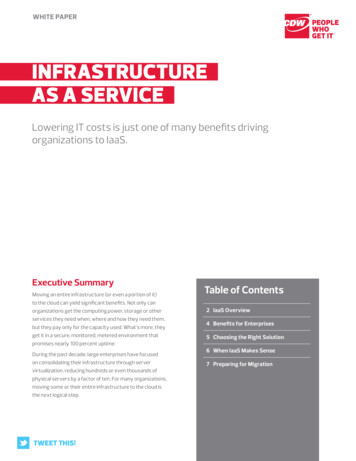
Transcription
White paperInfrastructure.as a Service.Lowering IT costs is just one of many benefits drivingorganizations to IaaS.Executive SummaryMoving an entire infrastructure (or even a portion of it)Table of Contentsto the cloud can yield significant benefits. Not only canorganizations get the computing power, storage or otherservices they need when, where and how they need them,but they pay only for the capacity used. What’s more, theyget it in a secure, monitored, metered environment thatpromises nearly 100 percent uptime.During the past decade, large enterprises have focusedon consolidating their infrastructure through servervirtualization, reducing hundreds or even thousands ofphysical servers by a factor of ten. For many organizations,moving some or their entire infrastructure to the cloud isthe next logical step.TWEET THIS!2 IaaS Overview4 Benefits for Enterprises5 Choosing the Right Solution6 When IaaS Makes Sense7 Preparing for Migration
2Infrastructure as a ServiceToday, many are making the choice to move to someand the opportunity for enterprises to shift the IT focusform of infrastructure as a service (IaaS) for help into their core mission or business instead of focusing theirmanaging data center computing resources. In a 2012resources on IT infrastructure.study, Enterprise Strategy Group found that 30 percent ofenterprises (defined as organizations with 1,000 or moreemployees) currently use some form of IaaS, compared to19 percent in 2011.PaaS vs. IaaSIf infrastructure as a service is a way to provide virtualmachines, servers, storage and other infrastructureThe study also found that an additional 55 percent areservices via the cloud, what is platform as a service (PaaS)?considering or plan to use IaaS in the future, comparedThere has long been confusion between the two — and forto 44 percent in 2011. The top four reasons for moving togood reason.IaaS include its availability as a resource for testing andBoth offer computing via the cloud, but at different layers.development, the ability to run production applications, theThe difference is this: The PaaS model provides both aavailability of additional resources to accommodate spikescomputing platform, consisting of application buildingin workload demands, and for use as a temporary computeblocks such as databases and file sharing, along withresource for time-limited projects.applications that run on the platform, while IaaS providesIaaS Overviewand networking components.At its core, infrastructure as a service is a way fororganizations to get the hardware, storage, networkingand other services they need to run their operationswithout worrying about buying, managing or maintainingthe equipment. With this model, enterprises “rent” theequipment, paying only for the capacity and spacethey use.An offsite service provider owns, manages and maintainsthe infrastructure building blocks only — storage, hardwareClearly, PaaS and IaaS are closely related, becauseapplications, platforms and infrastructure can’t workwithout each other. This has led some to speculate that thetwo eventually will become one layer of service. In the pastyear, Microsoft added an IaaS platform on top of its AzurePaaS platform, while Amazon added PaaS functions to itsIaaS platform.And just recently, HP announced plans to launch a cloudservice that will combine PaaS, IaaS and SaaS (softwarethe equipment, providing enough capacity to scale up oras a service). It will offer both structured and unstructureddown to meet the needs of its customer organizations.databases, along with data analytics as a service. It will alsoOrganizations access the resources (virtual machines thatoffer tools to help developers use software languages suchrun their applications) via a web browser.as Ruby, Java and PHP, as well as ways for users to provisionThere are many setups for IaaS, from full-blown computeas a service to partial infrastructure as a service, such asstorage, servers, web hosting and disaster recovery. Theamount of infrastructure an organization chooses to moveto the cloud depends on many factors, including its line ofbusiness, the availability IT staff and IT expertise, and cashflow constraints.There are also different ways of implementing IaaS: in aprivate cloud, public cloud or hybrid private/public cloud.Again, the path an organization chooses depends onseveral factors and usually comes down to balancing costwith security needs.Lowering costs is a major driver for adopting the IaaSmodel. Buying an equivalent amount of computing power(not to mention the expertise to manage those resourcesand guarantee uptime) would be prohibitively expensivefor many enterprises. Other benefits include flexibility,scalability, greater security, almost 100 percent uptimeTWEET THIS!and manage workloads remotely.Combining two layers (or even three) of cloud services isa trend that may grow over time. By adopting some cloudinfrastructure earlier rather than later, organizations willbe better prepared to move more services to the cloud — inwhatever form they happen to take.Although the features of different IaaS offerings andvendors vary, there are several that are fairly standard,including the following.Dynamic infrastructure scaling: The service provider isresponsible for ensuring the customer’s infrastructureneeds will always be met, even if they include peaks andvalleys. With this infrastructure model, organizations canalways be assured that they will have the IT resourcesthey need.Guaranteed uptime: IaaS providers guarantee 99.95percent or greater availability with 100 percent uptime. Thisis spelled out in the service-level agreement (SLA).
800.800.4239 CDW.comAutomation of administrative tasks: These tasks includethemselves can also develop their own or import imagesdeploying and managing virtual desktops and servers forfrom the existing operational environment.both employees and guests, managing virtual server pools,and monitoring ongoing activity such as disk utilization,network activity, active jobs, and member and guestactivity.Policy-based services: This feature imposes enterprisedefined policies on the infrastructure services that specificusers or user groups can access. Based on these policies,provisioning and decommissioning resources becomes anautomated process.Elastic load balancing: Based on requirements at any giventime, resources are balanced and distributed automatically,appropriately and efficiently across multiple virtualcomputers.That way, they know the images will meet theirconfiguration, security and compliance standards. It alsovastly increases the speed at which new instances of theimage can be deployed.Preconfigured templates: Qualified users can createpredefined templates for various types of virtual machines.This allows other users to choose from a preapproved listof templates, standardizing and removing risk from theprocess of quickly spinning up virtual machines.Access to the newest technology: Because organizationsdon’t own the equipment, they aren’t stuck withtechnology that will eventually become outdated and needan upgrade. Instead, they always have access to the latestCustomized machine images: With the IaaS model, buildingequipment, with the most up-to-date features and highestand deploying machine images on which applications canlevels of efficiency.run is fast, automated and customized to an organization’sspecific needs. IaaS providers offer a host of virtualmachine images to their customers, but organizationsGood Security Means Working TogetherThe security concerns organizations have about relegatingpart of their infrastructure to the cloud are much thesame as concerns they have (or should have) aboutmanaging virtualized machines. By far, the biggest worry isunauthorized use.Good security depends on the quality of the IaaS serviceprovider, along with the security controls they implement andhow well they monitor the environment. But they also dependon the controls the organization itself puts in place and howwell it communicates those controls to the IaaS provider.Whether the concern is disgruntled workers inappropriatelyaccessing resources and data or external cybercriminals,there must be a process and technology in place to detectsuch usage and shut it down immediately. Dependingon the organization, its applications and rules, that mayinclude security certificates, simple HTTP authentication orapplication programming interface (API) keys.Most cloud services are accessed using an API key —basically, a simple web services interface. Only qualifiedusers know the API key for a specific service, therebyincreasing security. Sometimes, protecting those APIkeys can be a concern. Usually API keys are protectedvia encryption or by storing them within a hardwaresecurity module.Another concern is how to secure data in transit. It’s best toask the IaaS provider how it accomplishes this. In general, theStringent security controls: Depending on the solutionand the vendor, an IaaS offering will be compliant with SSL(Secure Sockets Layer) or AES (Advanced Encryptionprovider should separate the network traffic of each user atthe lowest level possible: the hypervisor level. This preventsindividual users from viewing the traffic of other users.Another good way to ensure security is to separate privateand public network traffic.No matter what the security issue, it takes both parties toensure that the necessary processes are in place and thatdata protection is ironclad. In every case, it is importantfor the cloud service provider to work hand in hand withthe organization, pairing the IaaS provider’s cloud servicemonitoring with its own governance framework. The give andtake that this requires isn’t always easy, but it is critical.Another example of IaaS in action is website hosting. Insteadof running the website from on-premises hardware, anorganization can use IaaS to run its site and take advantageof the speed, uptime and resources that allow it to delivermarketing campaigns more quickly, handle spikes in webtraffic and respond quickly to trends.Yet another way an enterprise can use IaaS to remaincompetitive is through development and testing. Whenworking on new products, marketing campaigns and othercompetitive resources, it’s often necessary to quicklyincrease IT infrastructure for running specific workloadsand then throttle it back when the work is finished. The IaaSmodel provides the scalability and load balancing requiredto perform complex development and testing, and thenreduce capacity once testing and development havebeen completed.3
4Infrastructure as a ServiceStandard) encryption, employ a virtual private network(VPN) and provide role-based access control.Public, Private or Hybrid?Taken together or in bunches, IaaS features provide theWhether an organization chooses to move itsability to scale up and down quickly while paying only forinfrastructure to a private or public cloud depends onthe capacity actually used, which is important in today’smany variables, namely cost, security and compliancefast-paced, competitive environment. For example, to stayrequirements. If all things were equal, every organizationon top of the competition, an enterprise may want to createwould probably opt for a private cloud — the most secure ofbatch processes that run every night to better understandthe bunch. However, it is also the most expensive.its sales data.With a private cloud, organizations pay for a computingBut it may need ad hoc computing resources to do so.infrastructure dedicated solely to their core focus. PrivateAn IaaS infrastructure would give the organization thecapacity it needs for nightly intelligence gathering withoutlaying out significant budget.Benefits for EnterprisesWith IaaS, IT shops don’t have to buy, maintain or upgradesoftware, hardware or operating systems. They don’t haveto worry about network configurations. That can save bigclouds can be hosted on the organization’s premises orby an IaaS provider. But in either case, they don’t shareresources with other tenants. This is a viable option forenterprises that must cooperate with specific compliance,auditing or governance regulations.On the other end of the spectrum is the public cloud, whereinfrastructure is hosted in the IaaS provider’s data centerand often shared with other customers. But there arecaveats: If the organization deals in sensitive information,money, both up front and over time.such as healthcare data or sensitive personal or financialIaaS, like all cloud offerings, is a pay-as-you-go model. Sodata, a public cloud may not be the right avenue.organizations don’t have to manage large cash outlays.For these organizations, a hybrid cloud model often makesInstead, they pay only for the resources they use, which issense. With this model, sensitive functions are hosted in amore cost-effective than the traditional method of payingprivate cloud, while day-to-day functions are hosted in aset fees for services and equipment, even when they aren’tshared, public environment. The decision of whether a userbeing used. What’s more, there are usually no servicecontracts to deal with.For example, new product development may require atest and development environment that can be spun upquickly and then reduced when the test and developmentphase ends. Or an enterprise may have to scale veryquickly to meet demand, either because a product takes offrequest goes to the public or private portion of the cloud isbased on how policy is set.If a developer working on a product for a highly regulatedenvironment requests a resource, it would go to the privatepart of the cloud, versus a public-facing request, whichwould go to the less expensive, public cloud. This strategyoffers the best of both worlds, without overpaying forprivate infrastructure when it’s not needed.unexpectedly or to deal with expected seasonal spikes.Either way, the IaaS model allows enterprises to meetthose capacity spikes without having to add infrastructurewithin the data center, and to reduce capacity when thespike ends.The IaaS model also takes a lot of pressure off of IT staff,who generally are responsible not only for hardware andinfrastructure, but also for handling requests from line-ofbusiness owners, application developers and engineers.In a traditional IT environment, IT staff often don’t havethe resources to respond to all such requests in a timelymanner, forcing divisions to purchase services externally.With the IaaS model, requests can be filtered quicklythrough the IT department, maintaining internal policies andprocedures, and then sent to an IaaS vendor approved bythe organization, recommends Enterprise Strategy GroupSenior Analyst Mark Bowker.TWEET THIS!IaaS also is compatible with today’s anytime, anywherework model. Because everything in IaaS is web-based,administrators can manage the systems from anywhere,whether they are adding capacity, removing users oraccessing reports. Users can get the computing resourcesthey need from wherever they happen to be, significantlyimproving the agility of the organization as a whole.Finally, IaaS can solve the issue of inevitable systemupgrades. Technology changes rapidly, and those changesusually bring higher capacities, greater reliability and usefulnew features. Purchasing upgrades can be expensive,and organizations that rely on an internal IT infrastructuremust eventually upgrade their equipment (even virtualizedservers), either to increase capacity or features or becausea system has failed or is no longer supported by a vendor.
800.800.4239 CDW.comWith IaaS, that never happens because the equipmentOne of the concerns that organizations have about movingisn’t the organization’s problem — it’s the IaaS provider’sstorage to the cloud is security. After all, storage systemsresponsibility.contain sensitive information about the organizationsChoosing the Right Solutionand its users or customers. Cloud-based storage has thesecurity controls to ensure that all data is stored securely inThe term infrastructure is broad in meaning, so it’s notdata center facilities, with extremely high availability.surprising that subcategories of cloud-based services fallDisaster recovery and backup as a service: The ideaunder the IaaS moniker. Some of the most popular IaaSbehind moving disaster recovery to the cloud is to ensuresolutions include the following.that organizations have uninterrupted access to data andCompute as a service: One of the most ubiquitous IaaSapplications, regardless of emergencies, such as powerofferings today, compute as a service provides computeoutages, natural disasters or system failures. Thesecapacity that includes servers, operating system access,solutions always include redundancy and automaticfirewalls, routers and load balancing on demand. Thesefailover to ensure ongoing access, reducing downtime tosystems have management interfaces, and their capacitynearly zero.can be either shared or private.Many solutions also employ continuous data protectionDepending on the provider and the options an enterprise(CDP), which allows for multiple versions of all data sets tochooses, compute as a service also can include automatedbe recovered. This gives users the ability to restore data topatch management, management of infrastructureany point in time. Data and applications are stored in securesoftware, storage management, security management,offsite facilities.dedicated customer support and customized SLAs.There are two basic options when it comes to disasterWeb hosting: Many organizations rely on their websitesrecovery as a service: backup and restore from the cloudfor marketing and revenue, and any glitch in operationsand backup and restore to the cloud. With the first option,can mean a loss of business. Moving a website to an IaaS-organizations retain applications and data on their ownbased model ensures that the website won’t get boggedpremise, but back up data to the cloud and restore it todown during peak traffic times — and that organizationshardware on their own premise when a disaster occurs.won’t have to overpay for capacity to manage thoseWith the second option, data is restored to virtual machinestraffic spikes.in the cloud. For mission-critical applications and resourcesWhat’s more, loads will always be balanced, and uptime isthat must be recovered quickly and completely, the bestguaranteed, thanks to SLAs. Other perks include offsitechoice is often to replicate data to virtual machines.backup and fast connections for eliminating slow pageDesktops as a service: DaaS is, in essence, an IaaS cloudand content downloads, no matter how much rich mediacreated solely for hosting and serving virtual desktops.a site includes.Essentially, it’s pay-as-you-go computing that allowsStorage as a service: Storage is one of those necessitiesenterprises to quickly provision, access, run and deactivatethat only grows over time. It can be a constant strugglevirtual desktop machines as needed.to maintain enough storage capacity and manage itOrganizations can choose to connect through a privateeffectively. Storage as a service goes a long way towardnetwork service instead of the public Internet. In mosteasing the burden.cases, the service provider offers storage for the virtualThese solutions have interactive self-service portals thatcomputers, ensures security and data protection, andallow administrators to provision storage, transfer datacontrols the network bandwidth to ensure uptime.to different tiers of storage, dispatch specific data sets toMost solutions come with a self-service portal fordifferent media (such as disk or tape), and add or removeprovisioning and multitenant monitoring, reporting andstorage as needed. Storage-as-a-service providersbilling. DaaS is a way to make sure that there are alwaysalso have the latest storage technologies and virtuallyenough desktop environments available to new workers,limitless capacity.with enough storage and all the right applications. AndTiers generally include fast storage for high I/Obecause the desktops can be accessed via the Internet,applications, standard storage for system disk and bulkusers can log in and access their familiar workspaces fromstorage for file serving. And as with other types of IaaS,any location.enterprises pay only for what they use.5
6Infrastructure as a ServiceServers as a service: Accessing servers in the cloud meansthat no matter what the project, or even if it’s the busyseason, there will always be enough compute power togo around. It’s useful for one-time projects that requireadditional capacity, or for handling spikes in transactions.And because it’s a service, enterprises can rest assuredthat they’ll never be paying for more server capacityWhen IaaS Makes SenseAll enterprises are looking for ways to cut costs, and thecloud provides an opportunity. The pay-as-you-go modelmeans that organizations never pay for capacity not used.Plus, there are no more costs for upgrading hardware andother infrastructure, no more service contracts and few ifthan they need.any virtualization licensing costs.Accessing servers as a service also means organizationsOrganizations see cloud computing as a cost reductioncan cut their IT administrative, maintenance and serviceworkloads. That’s particularly important with servers,which can require complex and expensive systemadministration. The servers are restricted to secure,strategy for many reasons, according to a study byEnterprise Strategy Group: There is no need to renegotiatecontracts, no need to postpone projects for lack ofcapacity, and no need to dedicate staff to managingprivate areas dedicated to the organization’s use, soinfrastructure.security is ironclad.Organizational models that require the ability to quicklyNetworking as a service: This is the newest entrant in thereact to market changes are also good candidates for IaaS.IaaS category. The idea is to offer networking resources ondemand in order to support virtual networks — resourcesSuch organizations many need to stand up a system onshort notice, create or troubleshoot a product quickly orsuch as firewalls, load balancing and WAN accelerationget new employees up to speed in hours rather than days.services. Simply put, NaaS provides unified connectivityThat might be possible with an in-house infrastructure, butacross storage, networking and servers that changes tonot without some fast thinking around repurposing andmeet the demands of virtualized infrastructures.repositioning equipment. With infrastructure in the cloud,In some cases, a networking service can support qualitythe capacity is always there when needed.of service (QoS) and other network-based auditing andIt makes sense to consider IaaS when the data center ismonitoring services. As with other IaaS services, NaaSdue for a complete refresh or overhaul. That’s the timeinvolves no upfront costs and supports full scalability,to consider if it makes sense for the organization toflexibility and security.continue managing its own data center. Is that the bestuse of salaried employees? If an organization is not in theCloud Security: Help Is on the WaySecurity is the biggest reason many organizations hold backfrom moving to public-cloud services. In response, several ofthe most prominent security manufacturers have releasedproducts to ease these concerns.One category is cloud-based e-mail security. Products suchas Symantec.cloud and Panda Cloud Email Protection offervirus and spam protection, along with content and imagecontrol. Symantec also offers a product that delivers instantmessaging protection in the cloud.Cloud-based security for the web is another major category,IT business, chances are good that it may not be in its bestinterest to spend the money on new infrastructure.Saving money is a popular reason for moving to IaaS —or any type of cloud computing. But depending on thesituation, that may not always be the case. It’s worthtaking the time to do a complete cost/benefit analysis.That means considering every angle — the money anenterprise would save by not buying, maintaining andupgrading its own equipment, as well as the costs of laborthe organization is now paying to manage its internalinfrastructure.with offerings that include Trend Micro SecureCloud,Those are the hard costs, and they are fairly easy toMcAfee Cloud Security, Panda Cloud Office Protection andquantify. The bigger issue is determining the soft costs.M86 Secure Web Service Hybrid. These services blockFor example, if an organization is anticipating significantmalware and spyware and offer policy control and usergrowth but can’t be sure how much computing capacity itauthentication.will need, it’s difficult to run the numbers.Providers also offer cloud-based security services thatHowever, just knowing that a major growth stage is on thedeliver continuous-monitoring trend analysis.horizon is good information for a total-cost-of ownership(TCO) calculation. Because IaaS can be scaled up or downTWEET THIS!
800.800.4239 CDW.comquickly, it’s not as important to know how much theorganization will grow as it is to know that it will growsignificantly.But perhaps the most difficult costs to determine are“missed opportunity” costs. In other words, if an enterprisecan operate faster and better using an external IaaSprovider, it may gain some type of advantage that itcurrently can’t imagine.Preparing for MigrationAlthough making the leap from a physical infrastructureto an IaaS environment may seem overwhelming, thereis a logical way to structure the move. The first step is tovirtualize the current environment if the enterprise hasn’tdone so already (generally, servers first, followed byapplications, then desktops).By virtualizing as a first step, data and applications windup separated from the physical machines on which theyMany IaaS OptionsCDW offers several pathways for organizations to pursuean infrastructure as a service solution.CDW’s IaaS Solutions OfferingsVCE Vblock: The Vblock infrastructure platform is preengineered, pretested and preconfigured with compute,reside. This gives IT managers and executives a clearerunderstanding of which applications and data are mostimportant, along with the interdependencies among them.Through this process, it becomes clear which applicationsmake sense to port to the IaaS environment, which is itselfbased on a virtual infrastructure.network, storage, management and virtualization, enablingAt the same time, the virtualization process begins therapid deployment.cultural shift that will lead workers to access applicationsFlexPod: Jointly designed by NetApp, Cisco and VMware,and data through virtual machines. And it will train IT staffthe FlexPod data center solution is an integratedto deal with services-based, elastic, metered and scalableinfrastructure stack for all virtualization solutions. Itcomputing. The entire organization will begin movingincludes storage, networking and server technologies, astoward a service-based, shared-resources mindset — thewell as a secure multitenant architecture.same mindset and processes used in all cloud deployments.HP CloudSystem Matrix: This IaaS solution for private-The next step is to discover which applications andand hybrid-cloud deployments is an integrated hardware,software versions are in use throughout the environment,software and services solution that includes everythingwhich users have permission to use them and thenecessary for a self-service infrastructure portal. Ithas auto-provisioning capabilities, tools to manage andoptimize resource pools, multitenancy and a recoverymanagement solution.CDW Managed Infrastructure as a ServiceCDW’s managed IaaS offerings include: Dedicated Windows and Linux server instances, providingusers with highly customized virtual machines Pay-as-you-go data storage and backup Secure networking, including enterprise-class firewallsand load-balancing services Managed infrastructure services for hosted servers anddedicated network and server hardwareThe service can be hosted by CDW or Terremark.Build-Your-Own Cloud SolutionsWhen an organization wants specific functionality in ainterdependencies among those applications. Once thatinformation has been gathered, it’s important to collect andmeasure data about each application’s resource utilizationlevels — how much CPU power and memory does eachapplication use?IT shops will also need network and storage metrics,specifically as they describe throughput and latency. Thisdata is crucial to determining how the applications will workin the new IaaS environment.Application dependency mapping is next. This involvesidentifying dependencies between applications, as well asbetween applications and the data infrastructure. The ideais to find out how to architect the migration plan so thatthose dependencies aren’t disrupted. It’s a painstakingprocess, one that an outside consultant or a specialpurpose mapping tool can help with.private cloud it can build its own using leading platformsIt’s also important to ensure that the cloud-basedsuch as VMware’s vSphere or vCloud Director, orinfrastructure is compatible with the organization’sMicrosoft’s Hyper-V and System Center technologies.existing server hardware and operating systems. If thehardware isn’t compatible, applications may have to be7
Infrastructure as a Service800.800.4239 CDW.comredeployed or recompiled for the new platform. If theInfrastructure as a service makes a great deal of senseoperating systems are different, other changes may havefor many organizations. Agility and productivity are keyto be made when the enterprise migrates its systems.to surviving and thriving in a challenging economy. SoFinally, it’s important to prepare the IT staff for its changinganything that conserves cash and allows the enterprise torole. Although it might be tempting to think that the ITfocus its resources on the core business or mission is worthfunction will no longer be needed once an organizationconsidering.moves
Guaranteed uptime: IaaS providers guarantee 99.95 percent or greater availability with 100 percent uptime. This is spelled out in the service-level agreement (SLA). . Microsoft added an IaaS platform on top of its Azure PaaS platform, while Amazon added PaaS functions to its IaaS platform. And just recently, HP announced plans to launch a .
